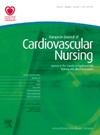评估 STEMI 后糖尿病患者的疼痛强度和镇痛需求
IF 3.9
3区 医学
Q2 CARDIAC & CARDIOVASCULAR SYSTEMS
引用次数: 0
摘要
导言 糖尿病患者发生心肌梗死、心力衰竭和急性心脏事件后死亡的风险明显更高。对糖尿病患者的疼痛强度和镇痛需求进行研究,可以全面了解糖尿病患者的疼痛经历和个体镇痛需求。研究目的 评估 STEMI 后糖尿病患者的疼痛强度和镇痛需求。材料和方法 该研究涉及 104 名参与者(女性 58 人,男性 46 人,平均年龄约 72 岁,M±SD= 11 岁)。研究在心脏研究所的心脏病重症监护室进行,从 STEMI 患者中收集数据。参与者分为两组:54 名糖尿病患者和 50 名非糖尿病患者。分析了性别、年龄、现有疾病、血红蛋白水平和是否患有糖尿病等因素对疼痛强度的影响。在糖尿病组中,还考虑了治疗方法、病程和糖尿病依从性对疼痛强度的影响。采用视觉模拟量表(VAS)评估疼痛,并使用镇痛阶梯评估镇痛需求。显著性水平为0.05。结果 分析表明,糖尿病对心肌梗死患者的疼痛强度有影响。糖尿病患者的疼痛明显减轻,但糖化 HbA1c 水平超过 7.0 毫克/分升的患者疼痛加剧。b 标准化回归系数表明,糖尿病与疼痛呈强负相关(β=-0.77,p = 0,008),而 HbA1c 水平与疼痛呈强正相关(β=0.88,p = 0,889)。对镇痛药的比较分析表明,糖尿病组使用的镇痛药较少(p=0.002)。糖尿病患者最常使用一线药物,而非糖尿病患者则需要二线镇痛治疗。糖尿病患者的疼痛程度为低度,而非糖尿病组的受访者则以中度疼痛为主。不遵从糖尿病患者的建议与较高的疼痛强度有很强的正相关性(β系数=0.90,p=0,010)。性别、年龄、是否有合并症、糖尿病治疗方法和持续时间对疼痛强度的影响均不明显。结论 分析表明,糖尿病对心肌梗死患者的疼痛强度有影响。糖尿病患者的疼痛感明显低于非糖尿病患者。糖尿病患者所需的镇痛阶梯等级较低。本文章由计算机程序翻译,如有差异,请以英文原文为准。
Assessment of pain intensity and analgesic requirements in patients with diabetes mellitus after STEMI
Introduction Patients with diabetes encounter a significantly higher risk of myocardial infarction, heart failure, and mortality following acute cardiac events. Examining pain intensity and analgesic needs in patients with diabetes can provide a comprehensive understanding of the pain experienced and individual analgesic needs in patients with diabetes. Aim of the study The aim was to assess pain intensity and analgesic requirements in patients with diabetes mellitus after STEMI. Material and Methods The study involved 104 participants (58 female and 46 male, with a mean age of approximately 72 years, M±SD= 11 yeas). The study was conducted at the Heart Institute, in the Intensive Cardiology Unit, and data were collected from patients following STEMI Participants were divided into two groups: 54 people with diabetes and 50 people without diabetes. The influence of factors such as gender, age, existing diseases, haemoglobin levels and the presence of diabetes on pain intensity was analysed. In the diabetes group, the effects of treatment method, duration of illness and diabetes compliance on pain intensity were also considered. A visual analogue scale (VAS) was used to assess pain, and analgesia requirement was assessed using an analgesic ladder. The level of significance wasp < 0.05. Results The analysis indicated the effect of diabetes on pain intensity in patients with myocardial infarction. Those with diabetes experienced significantly less pain, however glycated HbA1c levels above 7.0 mg/dl predisposed to experiencing more pain. The b standardized regression coefficient indicated for diabetes ,a strong negative correlation (β=-0.77 ,p = 0,008), and for HbA1c level ,a strong positive correlation (β=0.88 ,p =0,889). Comparative analysis of analgesics revealed lower usage in the diabetes group(p=0.002). Diabetes Patients, the most frequent use of first-line drugs while the group of patients without diabetes needed second-level analgesic treatment. Those with diabetes rated their pain level as low ,while the non-diabetic group was dominated by respondents with an intermediate pain level. Non-adherence to diabetic recommendations correlated with higher pain intensity , with a strong positive correlation (β coefficient=0.90, p = 0,010 ). No significant impact was observed based on gender, age, the presence of comorbidities, or the influence of diabetes treatment methods and duration on the intensity of perceived pain. Conclusions The analysis indicated the effect of diabetes on pain intensity in patients with myocardial infarction. Those with diabetes experienced significantly less pain than non-diabetes patients. Diabetes patients required a lower level of the analgesics ladder.
求助全文
通过发布文献求助,成功后即可免费获取论文全文。
去求助
来源期刊

European Journal of Cardiovascular Nursing
CARDIAC & CARDIOVASCULAR SYSTEMS-NURSING
CiteScore
5.10
自引率
10.30%
发文量
247
审稿时长
6-12 weeks
期刊介绍:
The peer-reviewed journal of the European Society of Cardiology’s Council on Cardiovascular Nursing and Allied Professions (CCNAP) covering the broad field of cardiovascular nursing including chronic and acute care, cardiac rehabilitation, primary and secondary prevention, heart failure, acute coronary syndromes, interventional cardiology, cardiac care, and vascular nursing.
 求助内容:
求助内容: 应助结果提醒方式:
应助结果提醒方式:


